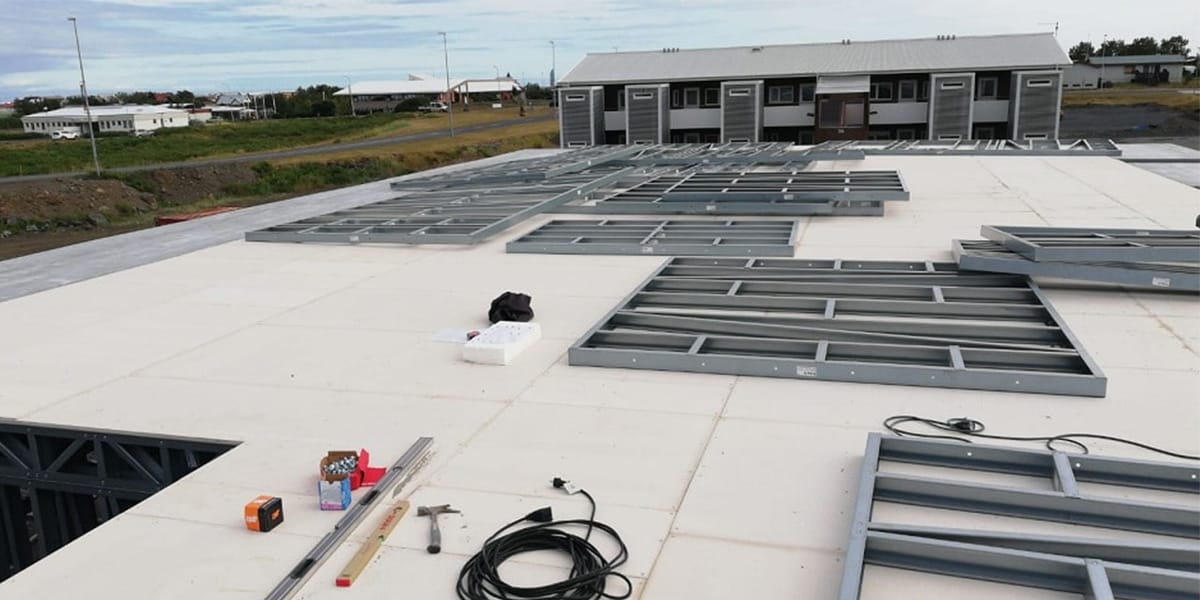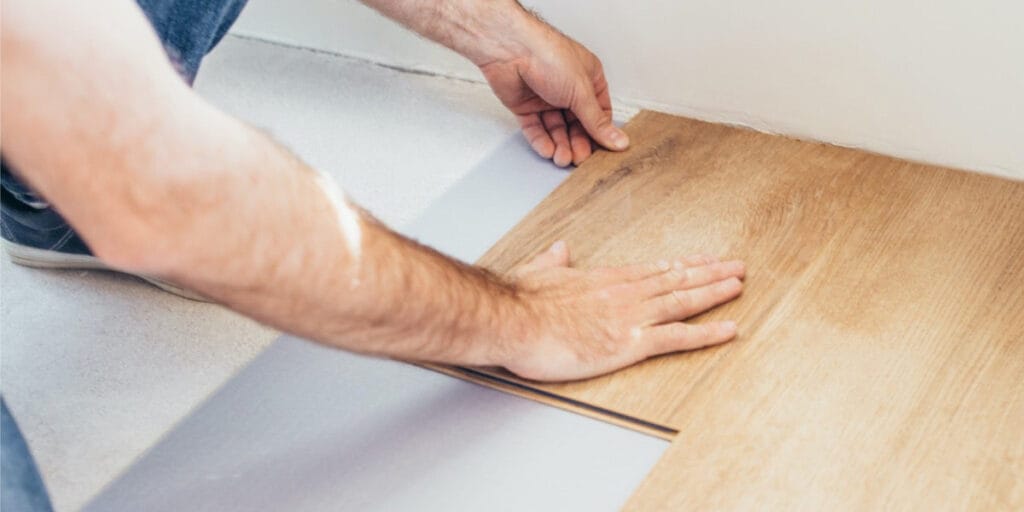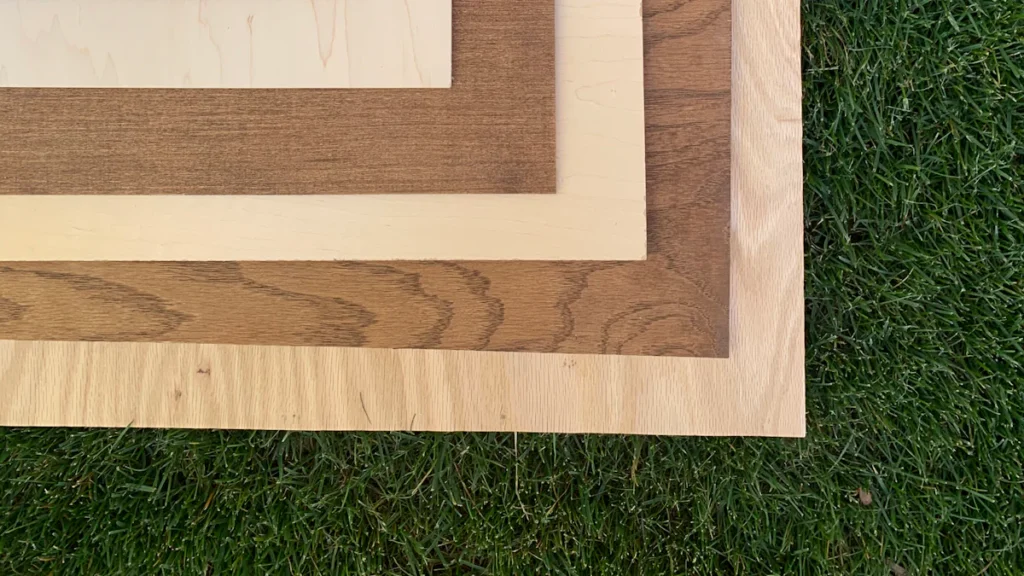
01 Mar MGO Board vs Plywood Board for Modern Construction
Table of Contents
Comparing MGO and Plywood Boards
Explore the key differences between MGO and plywood boards.
| Features | mgo board | plywood |
|---|---|---|
| Material Composition | Made from magnesium oxide and additives. | Made from layers of wood veneer. |
| Moisture Resistance | Highly resistant; does not swell. | Swells or warps with moisture exposure. |
| Fire Resistance | Non-combustible; withstands high temperatures. | Combustible; limited fire resistance. |
| Durability | Very durable; resists environmental factors. | Durable but less moisture resistant. |
| Weight | Heavier than plywood. | Lighter and easier to handle. |
| Cost | Higher initial cost. | More affordable upfront. |
| Environmental Impact | Eco-friendly; non-toxic materials. | Less sustainable; may involve deforestation. |
| Sound Insulation | Better sound insulation properties. | Less effective at sound insulation. |
| Lifespan | Longer lifespan due to resistance. | Shorter lifespan in high moisture areas. |
Selecting the right material for construction impacts the durability and sustainability of your project. Factors like fire resistance, moisture resistance, and cost play a vital role in this decision. Eco-friendly materials, such as MGO boards, align with sustainability goals by reducing carbon emissions and conserving natural resources. Plywood, known for its strength and versatility, remains a popular choice for structural applications. Comparing mgo board vs plywood board reveals unique advantages, helping you choose the best fit for your needs. Whether you prioritize durability or environmental impact, understanding these materials ensures informed decisions.
Material Composition
MGO Board Composition
MGO boards, also known as magnesium oxide boards, are made from a combination of materials that enhance their performance. These boards are designed to provide strength, durability, and resistance to environmental factors. Below is a breakdown of their components and how each contributes to their properties:
| Component | Contribution to Performance |
|---|---|
| Magnesium Oxide | Provides strength, durability, fire resistance, and moisture resistance. |
| Perlite | Enhances thermal properties and fire resistance. |
| Vermiculite | Improves thermal properties and moisture management. |
| Wood Fibers | Contributes to structural integrity and flexibility. |
| Fiberglass Mesh | Increases tensile strength and durability. |
This unique composition makes MGO boards, such as magpanel mgo, an excellent choice for modern construction projects requiring fire and moisture resistance.
Plywood Composition
Plywood is a versatile material made by gluing together thin layers of wood veneer. The type of plywood determines its specific properties and applications. Here’s a summary of its composition:
| Type of Plywood | Composition | Properties |
|---|---|---|
| Softwood | Made from coniferous trees | Suitable for general construction |
| Hardwood | Made from deciduous trees | Used for high-end furniture and cabinets |
| Marine | Specially treated for water resistance | Used for boats and outdoor structures |
| Composite | Combines wood with other materials | Used for specific applications requiring enhanced properties |
The layered structure of plywood provides strength and flexibility, making it a reliable option for various construction needs.
Key Differences in Material Properties
When comparing MGO boards and plywood, their material properties reveal distinct advantages for different applications. The table below highlights the major differences:
| Criteria | MGO Board | Plywood |
|---|---|---|
| Material Composition | Made from magnesium oxide (MGO), sand, and other additives. | Made from layers of wood veneer glued together. |
| Moisture Resistance | Highly resistant to moisture. Does not swell or warp. | Swells or warps if exposed to excessive moisture. |
| Fire Resistance | Excellent fire resistance (non-combustible). | Limited fire resistance and can catch fire in high temperatures. |
| Durability | Very durable. | Durable but less resistant to impact and moisture. |
| Weight | Heavier than plywood. | Lighter and easier to handle. |
| Cost | More expensive. | More affordable. |
| Environmental Impact | Eco-friendly due to non-toxic materials. | Not a sustainable option. |
| Sound Insulation | Provides better sound insulation properties. | Less effective at sound insulation than MGO. |
| Lifespan | Longer lifespan due to superior resistance to environmental factors. | Shorter lifespan, especially in high moisture areas. |
Understanding these differences helps you choose the right material for your construction project based on your priorities, such as durability, cost, or environmental impact.
Durability
Durability of MGO Board
MGO boards are known for their exceptional durability, making them a reliable choice for modern construction. These boards resist environmental factors like moisture, fire, and pests, ensuring a longer lifespan even in challenging conditions. Their composition, which includes magnesium oxide, perlite, and fiberglass mesh, contributes to their structural integrity and resilience.
To evaluate the durability of MGO boards, researchers have conducted various tests. The table below highlights some of these methods:
| Testing Method | Description |
|---|---|
| Accelerated Aging Tests | Simulates long-term exposure in controlled environments with high humidity and temperature. |
| Environmental Simulation | Exposes MGO boards to varying environmental conditions to observe property changes over time. |
| Long-Term Field Monitoring | Regular testing of samples from buildings with MGO boards installed for extended periods. |
These tests demonstrate that MGO boards maintain their strength and performance over time, making them suitable for structural applications in construction.
Durability of Plywood
Plywood offers durability through its layered structure, which provides strength and flexibility. However, its durability depends on the type of plywood and the conditions it is exposed to. For instance, marine plywood resists water better than standard plywood, while hardwood plywood is more robust than softwood varieties.
Despite its versatility, plywood is less resistant to environmental factors compared to MGO boards. It can warp or swell when exposed to excessive moisture and is vulnerable to pests like termites. Additionally, plywood is more likely to catch fire, which limits its use in fire-prone areas.
Comparative Analysis of Durability
When comparing the durability of MGO boards and plywood, MGO boards emerge as the superior option for long-term construction projects. Here’s why:
- MGO boards resist fire, moisture, and pests, ensuring consistent performance over time.
- Plywood, while strong, is more susceptible to environmental damage, including warping and pest infestations.
- MGO boards exhibit excellent compressive and bending strength, making them ideal for structural applications.
If you prioritize durability and a longer lifespan for your construction materials, MGO boards provide a more reliable solution than plywood.
Moisture Resistance

MGO Board and Moisture Resistance
MGO boards excel in moisture resistance, making them a reliable choice for areas prone to dampness. Their composition prevents swelling, warping, or degradation when exposed to water. This feature ensures that MGO boards maintain their structural integrity even in humid environments. Additionally, they offer mold and mildew resistance, which helps protect indoor air quality and reduces maintenance needs. These qualities make MGO boards suitable for bathrooms, kitchens, and other moisture-prone spaces.
Plywood and Moisture Resistance
Plywood provides moderate moisture resistance, but its performance depends on the type of plywood used. Marine plywood, for example, resists water better due to its special treatment. However, standard plywood tends to swell or warp when exposed to excessive moisture. Prolonged exposure can weaken its layers, leading to structural issues. Plywood also lacks natural mold and mildew resistance, which may require additional treatments or coatings to enhance its durability in damp conditions.
Comparison of Moisture Resistance
When comparing the moisture resistance of MGO boards and plywood, MGO boards clearly outperform plywood. The table below highlights the differences:
| Material | Moisture Resistance |
|---|---|
| MGO Boards | Highly resistant to moisture. Does not swell or warp. |
| Plywood | Swells or warps if exposed to excessive moisture. |
MGO boards provide superior water resistance, ensuring long-term durability in wet environments. Plywood, while versatile, requires careful selection and treatment to handle moisture effectively. If you prioritize moisture resistance for your project, MGO boards offer a dependable solution with minimal maintenance.
Fire Resistance
Fire Resistance of MGO Board
MGO boards stand out for their exceptional fire resistance. These boards are non-combustible, meaning they do not ignite or contribute to the spread of fire. In safety tests, MGO boards withstand temperatures up to 800 degrees Fahrenheit without losing structural integrity. Their fire resistance rating can reach up to four hours, making them a reliable choice for fire-prone areas. This high level of protection ensures that buildings using MGO boards remain safer during emergencies. Additionally, the material’s non-combustibility helps slow down fire progression, giving occupants more time to evacuate.
Fire Resistance of Plywood
Plywood, while versatile, offers limited fire resistance. It is a combustible material, which means it can catch fire easily and contribute to its spread. Without additional fireproofing treatments, plywood struggles to withstand high temperatures. In safety tests, plywood shows vulnerability to heat and flames, making it less suitable for applications requiring high fire resistance. While treated plywood can improve performance, it still falls short compared to the inherent fire-resistant properties of MGO boards. This limitation makes plywood a less ideal option for areas where fire safety is a top priority.
Comparative Analysis of Fire Resistance
When comparing the fire resistance of MGO boards and plywood, the differences are significant. The table below highlights key features:
| Feature | MGO Boards | Plywood |
|---|---|---|
| Fire Resistance | High; non-combustible | Limited; catches fire easily |
| Temperature Resistance | Withstands up to 800°F | Vulnerable to high temperatures |
| Fire Resistance Rating | Up to 4 hours | Variable; requires additional fireproofing |
| Combustibility | Non-combustible | Combustible; spreads fire |
MGO boards clearly outperform plywood in fire resistance. Their ability to withstand extreme heat and prevent fire spread makes them a safer and more dependable choice for modern construction. If fire safety is a critical factor in your project, MGO boards provide unmatched protection.
Environmental Impact
Sustainability of MGO Board
MGO boards offer several environmental benefits, making them a sustainable choice for modern construction. These boards are made from natural, non-toxic materials, ensuring they do not release harmful chemicals like formaldehyde or VOCs. This feature improves indoor air quality and promotes healthier living spaces. Their production process generates fewer carbon emissions compared to traditional materials, aligning with eco-friendly construction practices.
The durability of MGO boards also contributes to sustainability. They resist fire, mold, and water, which extends their lifespan and reduces the need for frequent replacements. At the end of their life cycle, MGO boards can be recycled or biodegraded, minimizing landfill waste. Additionally, their thermal resistance enhances energy efficiency, lowering heating and cooling costs. The table below summarizes these benefits:
| Environmental Benefit | Description |
|---|---|
| Low Carbon Emissions | Produced with fewer CO₂ emissions compared to traditional materials. |
| Non-Toxic Composition | Free from harmful chemicals, improving indoor air quality. |
| Durability | Long-lasting, reducing material waste. |
| Recyclability | Can be recycled or biodegraded, minimizing landfill waste. |
| Energy Efficiency | Provides thermal resistance, reducing energy consumption. |
Sustainability of Plywood
Plywood, while versatile, raises concerns about its environmental impact. Its production often involves unsustainable timber harvesting, which contributes to deforestation, particularly in tropical regions. This practice threatens biodiversity and accelerates climate change. The manufacturing process also has a high carbon footprint due to emissions from transportation, processing, and resin application.
Plywood may contain adhesives that release formaldehyde, which can harm indoor air quality. Additionally, its shorter lifespan compared to MGO boards means it requires more frequent replacements, leading to increased material waste. While some plywood options use sustainably sourced wood, they remain less eco-friendly overall.
Comparative Environmental Impact
When comparing MGO boards and plywood, MGO boards emerge as the more sustainable option. They are made from recyclable materials and have a lower carbon footprint. Unlike plywood, MGO boards do not contribute to deforestation or release harmful chemicals. Their durability and recyclability further enhance their eco-friendliness. In contrast, plywood production often involves deforestation and generates higher greenhouse gas emissions. For environmentally conscious builders, MGO boards provide a greener, more sustainable solution.
Cost
Cost Analysis of MGO Board
MGO boards have a higher upfront cost compared to plywood. This is due to their advanced material composition, which includes magnesium oxide, perlite, and fiberglass mesh. These components enhance their fire resistance, moisture resistance, and durability. While the initial investment may seem significant, MGO boards often prove more cost-effective over time. Their longer lifespan reduces the need for frequent replacements, and their resistance to environmental factors minimizes repair costs. Additionally, MGO boards can lower energy expenses by improving thermal insulation, making them a smart choice for cost-effective subflooring and other applications.
Cost Analysis of Plywood
Plywood is generally more affordable than MGO boards, making it an attractive option for budget-conscious projects. Its layered wood veneer structure is less expensive to produce, and its lightweight nature simplifies transportation and installation, further reducing costs. However, plywood’s susceptibility to moisture, pests, and fire can lead to higher long-term expenses. Repairs and replacements may become necessary, especially in environments with high humidity or fire risks. While treated plywood can improve performance, it adds to the overall cost, narrowing the price gap between plywood and MGO boards.
Cost Comparison for Modern Construction
When comparing the cost of MGO boards and plywood, several factors come into play:
- MGO boards require a higher initial investment but offer significant long-term savings due to their durability and resistance to environmental damage.
- Plywood has a lower upfront cost but may incur higher expenses over time because of frequent repairs and replacements.
- For projects prioritizing longevity and minimal maintenance, MGO boards provide a more cost-effective solution. On the other hand, plywood remains a practical choice for short-term or low-budget applications.
Ultimately, your choice depends on your project’s budget and long-term goals. If you seek a durable, cost-effective subflooring or wall material, MGO boards deliver excellent value despite their higher initial cost.

Suitability for Modern Construction
Applications of MGO Board
MGO boards serve a wide range of purposes in modern construction due to their durability, fire resistance, and moisture resistance. Their versatility makes them suitable for both interior and exterior applications. Here’s a breakdown of their common uses:
| Application | Description |
|---|---|
| Wall and Ceiling Panels | Ideal for interior and exterior walls, offering strength and better performance than traditional materials. |
| Flooring | Provides a durable foundation for high-traffic areas, supporting various flooring types. |
| Roofing and Siding | Resists high temperatures and moisture, making it perfect for external applications. |
| Fireproof Barriers | Used in fire-rated walls and ceilings to enhance fire safety in buildings. |
| Wet Area Lining | Moisture-resistant, suitable for bathrooms, kitchens, and other damp spaces. |
| Soundproof Buildings | Offers soundproofing, making it ideal for offices, hospitals, and schools. |
| Prefabricated Buildings | Lightweight and easy to install, making it practical for modular construction. |
These applications highlight why MGO boards are a preferred choice for projects requiring durability, safety, and environmental sustainability.
Applications of Plywood
Plywood remains a popular material in construction due to its affordability, strength, and ease of use. Its versatility allows it to be used in various structural and decorative applications. Common uses include:
- Interior Walls: Strong and flexible, suitable for framing and paneling.
- Cabinets: Durable and cost-effective for cabinet backs and sides.
- Roofing and Flooring: Frequently used for subflooring and roof sheathing.
- Furniture: Ideal for making dressers, shelves, and other furniture items.
- DIY Projects: Perfect for home projects like birdhouses or workbenches.
- Exterior Walls: Provides structural support and stability as wall sheathing.
Plywood’s layered construction ensures strength and resistance to warping, making it a reliable material for both structural and decorative purposes.
Final Comparison for Modern Construction Needs
When comparing MGO boards and plywood for modern construction, each material offers unique advantages. MGO boards excel in durability, fire resistance, and moisture resistance, making them ideal for projects prioritizing safety and longevity. They are particularly suited for fireproof barriers, wet areas, and soundproof buildings. On the other hand, plywood is more affordable and easier to work with, making it a practical choice for budget-conscious projects like furniture, interior walls, and DIY tasks.
The table below summarizes the key considerations:
| Criteria | MGO Board | Plywood |
|---|---|---|
| Durability | Highly durable, resistant to moisture and fire. | Durable but less resistant to moisture and fire. |
| Applications | Best for fireproof barriers, wet areas, and soundproofing. | Ideal for furniture, interior walls, and DIY projects. |
| Cost | Higher initial cost but long-term savings. | Lower upfront cost but higher maintenance expenses. |
| Ease of Installation | Requires special tools for cutting. | Easy to cut and install with standard tools. |
Choosing between MGO boards and plywood depends on your project’s specific needs. If you prioritize safety, durability, and sustainability, MGO boards are the better choice. For cost-effective and versatile solutions, plywood remains a reliable option.
MGO boards and plywood boards each bring unique strengths to modern construction. MGO boards excel in critical areas like fire resistance and moisture resistance. They remain impervious to water, maintaining structural integrity without swelling or warping. Their non-combustible nature ensures safety in fire-prone environments, making them ideal for sustainable and secure projects. Additionally, their eco-friendly composition aligns with green building practices.
Plywood boards, on the other hand, offer versatility and cost-effectiveness. Their durability and structural strength make them suitable for applications like flooring, roofing, and furniture. Plywood’s affordability and low maintenance requirements enhance its appeal for budget-conscious projects. Iconic structures like the Metropol Parasol in Spain showcase plywood’s adaptability and reliability in construction.
Your choice depends on your priorities. If you value safety, sustainability, and long-term performance, MGO boards provide unmatched benefits. For flexible, cost-efficient solutions, plywood remains a dependable option. Evaluate your project’s needs to select the material that best aligns with your goals.
